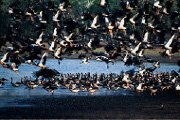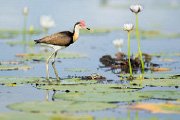Caring for Country
Kakadu is Aboriginal land. Our people have kept it healthy for thousands of years.
Today we work with Parks Australia to manage Kakadu using a mix of traditional ways and modern science.
Kakadu’s plants grow quickly after the monsoonal rains of the tropical summer. As the land dries out, this vegetation can become fuel for dangerous bushfires.
Kakadu’s park rangers work with us using traditional cultural burning methods to clear this fuel and prevent big bushfires later.
Cultural burning
We light small, cool and patchy grass fires across the landscape during the early dry season from around April through to July, and during the wet season between January and February.
These low intensity fires encourage new growth, while creating a barrier for severe and large fires that can burn out of control in the late dry season. Using small fires also means animals have plenty of time to escape to unburnt habitat and at the same time it generates new environments for diverse plants and animals.
This way of burning has developed over many generations. Before non-Aboriginal people arrived, we lit fires for many reasons:
- to make travelling easier
- to flush out animals when hunting
- to protect food resources (such as yams) from later fires
- to clear around camp sites
- to signal to others
- to fulfil spiritual and cultural obligations.
But when non-Aboriginal people arrived, the pattern of fire management changed and less burning was carried out, and hot, late dry-season wildfires became more common.
The fires were often large and destructive, this changed the mix of plants and animals. Since Kakadu was declared a National Park, we have worked with park managers to fix this.
Caring for Country using age-old cultural burning techniques is just one example of our joint management work with Parks Australia.
Take the first step
A journey of 1000 miles begins with a single click.
Enter your email to get free trip planning advice from Kakadu rangers.





